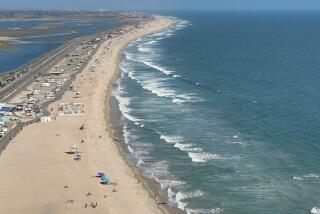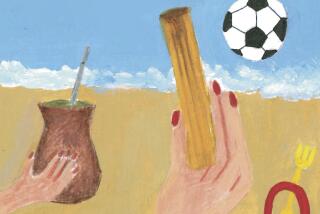PUNTE DEL ESTE : The Summer playground of Wealthy Argentines
- Share via
PUNTA DEL ESTE, Uruguay — Deserted most of the year, fashionable Punta del Este with its magnificent mansions is about to come alive, our correspondent tells us.
--Jerry Hulse, Travel Editor
You may imagine that somewhere the ocean is crystal clear. The sky is blue as aquamarine and the air is clean. The boulevards are wide and the shops are chic. The estates are sleek and sumptuous.
Beaches stretch for miles, opening onto the calm waters of a protected bay or the thunderous surf of the open sea. Natural geometric designs play on the empty sand dunes, unmarred by a single footprint.
If you came to a place like this, and it was all but deserted, you might imagine that the world has taken leave of its senses, or that they have put out the call to abandon the good ship Earth and everyone left but you.
The millionaires’ mansions of this place would fit in perfectly in Bel Air or Beverly Hills. And yet for at least nine months every year the resort lies nearly empty . . . only the gardeners tending their turf and the locals minding the quiet portion of their dual lives.
The latitude of this curious resort community is the same as the Mediterranean. The hurricanes that plague the Caribbean, far to the north, don’t come this way. There is nothing to disturb the serenity of day after sunny day.
This is the summer playground of wealthy Argentines, of millionaires who find it advantageous for one reason or another to invest their money outside their own country, and Punta del Este is the handiest place.
A point of land on the southeast edge of Uruguay, it is a prime location, with Rio de la Plata washing the beach on one side and the Atlantic Ocean on the other, just four blocks away.
While huge estates spread throughout the suburbs, rows of expensive high-rise condos face the ocean views closer to the center of town. Fully staffed and luxuriously furnished, the high-rises too are vacant most of the year. One imagines an empty stage, or a movie about to begin, or the blank page that precedes “Chapter I.”
Action runs from mid-December to mid-February when the Argentines return for another season of playing and partying. Fashionable shops, nightclubs and restaurants swing open their doors, and the money flows lavishly, along with the wine.
“We make our living for the year in those two months,” said the owner of the Mariskonea, a Greek-style restaurant and tavern that one patron called “the best restaurant between Rio and Patagonia.” It serves fresh mussels, crabs and clams in “high season” when patrons jam the place every night, waiting an hour or two to be seated. “This year we want to add a dozen more tables.”
But from March to November, the restaurant opens its doors only on weekends to serve a small gathering of year-round residents.
Another good restaurant is Mariscaria el Mastil, near the Yacht Club, where I dined on shrimp drenched in garlic and lemon, lettuce and tomato drenched in oil and vinegar, and Uruguayan wine-- vino fino blanco --and watched the sun setting over the harbor.
One can walk on the wind-swept Atlantic shore, looking toward the high-rises in town or to the mansions that line the beach, Playa la Draga, and hear only the sound of the surf and an occasional gull, and see not another soul.
I was one of a handful of guests at L’Auberge, a French-country-style hotel in the midst of the elegant suburbs. There was no restaurant service but I was served a simple supper in my room, and found a 1929 book of short stories to read. (This beautiful and very quiet accommodation cost $45 a night.)
For all its elegance and solitude, I moved from L’Auberge to La Capilla, a small and sunny hotel, with restaurant, closer to town. (Room with breakfast, $30.)
The large Hotel Casino San Rafael, a first-class hotel on the seafront, looked like it could be an action place when the crowds returned. It was closed for renovations.
La Capilla is installing a health club and sauna, and hopes to draw weekday and off-season guests to a new venture: Vida Total, Instituto Dietetico y de la Estetica (institute for diet and beauty), Uruguay’s first “fat farm.” The director is Dr. Marta Varela, a heart specialist.
She will focus on diet and exercise to prevent heart problems, dieting to reduce stress or to lose weight, along with advice on makeup and hair styling, for both men and women.
Besides all its obvious attractions of setting and climate, Punta del Este is an ideal place for health-seekers to congregate, Dr. Varela said. There’s something about the pine forests and the yodo (iodine) in the ocean that rejuvenates people, she believes. Besides, there’s no pollution, no industry, none of the usual stress factors.
The city’s permanent population is between 10,000 and 20,000 (estimates vary) and summer visitors number up to 400,000 a season.
As for the Argentines, they come for two reasons--to relax and to party--and they do both on a grand scale, zooming around town in low-slung sports cars, flying in musicians from Buenos Aires for a special party, importing their friends for long weekends.
They generally sleep until noon, I was told, and after the lightest of breakfasts, with the strongest of coffee, they head for the beach or into town, and around 4 in the afternoon they have a leisurely lunch with wine or cocktails.
Punta del Este has an excellent golf course that often hosts international tournaments. Tennis is available at many locations. Horses can be rented. Fishing is excellent all along the coast and boats can be rented from the Yacht Club. The best shopping is along the main street, Avenida Gorlero, which is also a great place for sitting at an outdoor cafe and watching the world go by. A number of small hotels line the side streets off Gorlero.
Then it’s anyone’s guess what goes on behind the windows at dusk; some surely linger to watch the sun set over the river, turning the cloud-washed sky from red to mauve to maroon, as two by two the lights go on--one light in reality, one reflected in the still water--while endless discussions take place over half-empty bottles of wine, a servant hovering in the background, unobtrusive but on call at the flick of a wrist.
Supper is served around midnight, then it’s off to a disco or a party until the faint promise of dawn sends the revelers homeward for another sleep until noon.
“They would like to stay all year,” said Hugo Peluffo, head of the hotel and restaurant association of Punta del Este. “But of course, they have to go back to their homes. They have their work, their lives in Argentina. This place for them is for vacation only.”
There’s a large and very odd sculpture at Playa el Emir, on the Atlantic side of town, that’s been there for about five years. It looks like the tips of four fingers and a thumb protruding from the sand. No one I asked seemed to know why it was there or what it symbolized.
It made the same amount of sense to me as the millions of dollars worth of real estate that sits empty for most of the year so that absentee owners can come and live it up for a couple of months, where questions like “Why?” are answered with a shrug: “Why not?”
Where else in the world is so much elegance abandoned for long to serve so few? But no one seems to mind. The gardeners and housekeepers reign for a long time, and then reap enough income in a short time to finance another long off-season.
Has anyone thought of renting out their luxury condo or their spacious mansion in the off-season? I asked Peluffo.
“No,” he said, smiling. He thought about it a moment and then he shrugged. “Who would want to come when no one is here?”
More to Read
Sign up for The Wild
We’ll help you find the best places to hike, bike and run, as well as the perfect silent spots for meditation and yoga.
You may occasionally receive promotional content from the Los Angeles Times.






